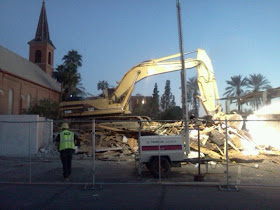 |
| Goodyear Farms, Southwest Cotton Gin and Cattle, Arizona, 1943 (Source: Jose Villela Photography Collection) |
 |
| Goodyear Farms Cemetery Mural depicting the laborers and fields of Litchfield Park during the early and mid 1900s (photo by Zack Wallace, April 2011) |
 |
| One of the only remaining structures from the days of the camps, St. Thomas Aquinas Church played an important role in the lives of the workers and their families (photo by Zack Wallace, April 2011). |
Goodyear Farms Cemetery
1/4 mile south of West Indian School Rd on North Santa Fe Trail
St. Thomas Aquinas Church
East Wigwam Blvd and South Neolin Ave, Litchfield Park, AZ 85340
In the early 1900s, the Goodyear Tire and Rubber Company, struggling to meet cotton demands to produce tires and rubber, established a subsidiary in Arizona named the Southwest Cotton Company. Goodyear chose Arizona due to its climate, which is very similar to that of Egypt, which was a large producer of cotton at the time. The first camp Goodyear set up was just south of present day Chandler. Eventually Goodyear found land in the present day Goodyear-Avondale area, west of downtown Phoenix. The company focused on this area, and sold its land near Chandler to a California company. Eventually, the headquarters for the Southwest Cotton Company moved from downtown Phoenix to Litchfield Park. The town of Litchfield Park, located about 20 miles west of downtown Phoenix, was created by Goodyear and the Southwest Cotton Company to house its workforce.
In 1917, the Southwest Cotton Company sent representatives to Mexico to recruit laborers, who were granted entrance into the United States through a six-month bond granted by the immigration service (Lucio 88). There were a total of five camps associated with the Goodyear Tire and Rubber Company. All were located in what is now known as the Goodyear, Avondale and Litchfield Park tri-city area. The first of the camps, Camp 50, also referred to as ‘Camp Algodón’ or ‘Centro’ was the main camp. It was located near the intersection of Indian School Road and Dysert Road. Camp 51 was located just south of Camp 50. Camp 52 was located west of Litchfield Road and south of Roosevelt Irrigation District. Camp 53 was located at the corner of Indian School Road and Alsup Road. Camp 54 was located two miles south of Camp 53.
Although wages at the camps were low, they were still attractive to Mexican laborers because housing was provided for free, unlike other similar labor camps in the Phoenix area. Mexican culture was maintained in the camps, and Mexican holidays were observed. The families of the laborers toted flags of both the United States and Mexico during these celebrations, showing their loyalty to their new country, while holding onto and their Mexican roots and culture. Mexican culture was most preserved through the Catholic Church. Children were taught about their faith, mainly by their mothers, and were brought to the local church, St. Thomas Aquinas, for mass and to gather with children from other camps for significant moments in the life of a Catholic, such as First Communion.
Today, none of the buildings associated with these camps are standing. Most were demolished during the 1990s to make way for expanding suburban development. However, St. Thomas Aquinas Church is still standing, as is the cemetery where many of the Mexican laborers from the camps were buried, now referred to as the Goodyear Farms Historic Cemetery, or the Litchfield Cemetery. The Church appears to be in good condition, but remains locked and seemingly unused. The Cemetery contains many graves, the majority of which are unmarked. However, the cemetery does house a mural near the entrance. The mural depicts the fields of the area, as well as the Mexican laborers who worked those fields and their families. Many of the people in the mural are mourning the death of a fellow friend or family member while Jesus looks over them and their colleagues working the fields in the background.
These camps have left a lasting impression on the area as many of the descendants of those who worked in the camps now live in the Litchfield Park-Goodyear-Avondale area. This area houses a large Latino population and is seems very supportive of preserving the Mexican and Latin American cultures represented in the area.
It is important to note that although similar, The Goodyear Tire and Rubber Company camps were not part of the Bracero Program that was seen during the World War II era. The Goodyear camps preceded the Bracero Program by about 20 years.
- Zack Wallace and Erin Seivley
References
Cuadraz, G. H. (2007). Mexican Americans and Litchfield Park: An Oral History Project. Tempe: Arizona State University.
“Goodyear Farms, Southwest Cotton Gin and Cattle, Arizona, 1943” in Jose Villela Photography Collection, MP Photographs,
http://www.asu.edu/lib/archives/digital-collections/AZSW/full/MP_SPC_313_1_13.JPG (accessed April 23, 2011)
Jesus Rosales Rios, "Photo of bracero in camp," in Bracero History Archive, Item #521, http://braceroarchive.org/items/show/521 (accessed April 12, 2011).
Lucio, David Drew (2007). Mexican Suburbanization in the Salt River Valley: Resurrecting the Memory of Litchfield Park (Master’s thesis). Arizona State University, Hayden Library, Tempe, AZ.
Rankin, T. (2009, January). Litchfield Farms Historic Cemetary. Three Rivers Historical Society Quarterly, 6, 4.
St. Thomas Aquinas Catholic Church. (2010, Spring). Litchfield Legends, n/a, 3-6.
The Women of Goodyear Farms (1916 - 1986). (n.d.). Arizona Women's Heritage Trail.
Retrieved April 11, 2011, from http://www.womensheritagetrail.org/women/GoodyearFarms.php

















